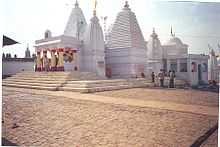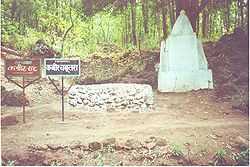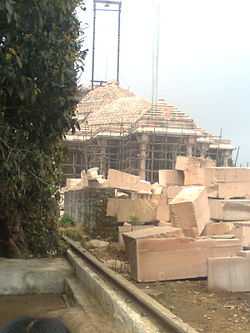Amarkantak
| Amarkantak अमरकंटक AmraKutt | |
|---|---|
| Hill station | |
|
Forests of Amarkantak | |
| Nickname(s): Maikal | |
 Amarkantak Location in Madhya Pradesh, India | |
| Coordinates: 22°40′N 81°45′E / 22.67°N 81.75°ECoordinates: 22°40′N 81°45′E / 22.67°N 81.75°E | |
| Country |
|
| State | Madhya Pradesh |
| District | Anuppur |
| Elevation | 1,048 m (3,438 ft) |
| Population (2001) | |
| • Total | 7,074 |
| Languages | |
| • Official | Hindi |
| Time zone | IST (UTC+5:30) |
| PIN | 484886 |
Amarkantak (अमरकंटक) is a pilgrim town and a nagar panchayat in Anuppur District in the state of Madhya Pradesh, India. Also called "Teerthraj" (the king of pilgrimages), Amarkantak region is a unique natural heritage area and is the meeting point of the Vindhyas and the Satpuras, with the Maikal Hills being the fulcrum. This is where the Narmada River, the Son River and Johila River emerge.
Etymology
Amarkantak is a combination of two Sanskrit words, amar (immortal) and kantak (obstruction). The place was abode of gods but was disturbed by the hindrances of Rudraganas and hence called Amarkantak. The poet Kalidas has mentioned it as Amrakuta, which later became Amarkantak.[1] Myth is that the dense forests of this region were full of mango (amra) trees.
Location
Amarkantak is in the state of Madhya Pradesh in India at 22°40′N 81°45′E / 22.67°N 81.75°E. It has an average elevation of 1048 metres (3438 ft). Roads running through Rewa, Shahdol, Anuppur, Jabalpur, Katni and Pendra connect it. The nearest railway stations are Anuppur and Pendra Road 43 km via Keonchi and only 28 km via Jwaleshwar. The nearest airport is Dumna Jabalpur (Jabalpur Airport) in the city of Jabalpur, Madhya Pradesh (240 km) which has daily flight service to Delhi and Mumbai.[2] [3]
Demographics
As of 2001 India census,[4] Amarkantak had a population of 7074. Males constitute 54% of the population and females 46%. Amarkantak has an average literacy rate of 68%, higher than the national average of 59.5%; with 62% of the males and 21% of females literate. 17% of the population is under 6 years of age.
Geography
As well as the Narmada, the Son River, initially referred to as Jwalawanti of Johila, the Narmada and the Amadoh, which is a major early tributary of the Godavari, all rise from the Amarkantak plateau. The beauty of the plateau can well be gauged from the fact that it lies 1000 metres a.m.s.l. in the midst of a moist sal and mixed forest. A little distance from Gaumukh, the source of the Narmada, is Kapildhara, where the Narmada leaves Anuppur District and enters Dindori District by cascading more than 20 metres down a sheer basalt rock. Four kilometres from Amarkantak is Kabir Chabutara, the exact junction point of Dindori, Bilaspur and Anuppur districts. As the source of the Narmada, which is more than 150 million years older than the Ganges and is considered by many Hindus to be the most sacred of all the rivers of India, Amarkantak itself is sacred to the Hindus and is deemed to be a doorway to ‘nirwana’.
In these hills dwell some of the most primitive of the Madhya Pradesh tribals, the Hill Korwas and Pandavas. Even today the Pandavas run away if they see any strangers approaching their village.
Geologically the Amarkantak Hills have underlying basalt (Deccan Traps). The overburden consists of bauxite and laterite, making the soil ferruginous and clayey, with an acidic or neutral reaction. There is schist and gneiss, which is why sal is to be found here despite underlying trap. Climatically Amarkantak is temperate.
July, August and September are the monsoon months, and there is some winter rain. February is about the only month which is dry.
Flora and fauna
The temperate climate and the equitable distribution of rain make Amarkantak an ideal plateau for dense vegetation cover. From 1970 to 1976 H.O. Saxena, the forest botanist, State Forest Research Institute conducted intensive studies on the flora of Amarkantak, which is classified by Champion as Central Indian sub-tropical hill forests. He identified 635 species, including 612 angiosperms, 2 gymnosperms and 21 pteridophytes. 7 of these species were new for Central India and 14 for Madhya Pradesh. Whilst the forest is sal-dominated, there are associate species such as Mallotus philippensis (Kumkum), Buchanania lanzan (Chironji), Ougeinia oojeinesis, Terminalia chebula, Bauhinia spp, Grewia spp, Gardenia latifolia, Anogeissus latifolia, with climbers and shrubs such as Bauhinia vahilii, Dioscorea, Smilax, Celastrus painiculata and such ground flora as Desmodium, Moghania, Sida, Crotalaria, Leucas, Pogostemon benglaensis, Strobilantihes, Setaria, Oplismenus etc.
As one moves down into the valleys, sal gradually is replaced by mixed forests, which include Bauhinia retusa, Grewia spp. Bursera serrata (which is normally to be found in the northeast and whose presence in Amarkantak shows the catholicity of vegetation here), Rhamnus wightii, Schleichera oleosa (Kusum), Schefflera venulosa, Butea monosperma (Palash), Lagerstoemia parviflora, Boswellia serrata, Garuga pinnata, Ficus spp, Lannea coromandelica, etc., with a wide variety of grasses and other ground flora. Interestingly there are plants of the northwest and central Himalayas to be found in Amarkantak, including Thalictrum foliolosum, Ceranium Ocellatum, Androsace umbellata, Mazur delavavi, Lindernia Hookeri var. Kumannensis, etc. Because of the high percentage of grasses in Amarkantak, the ratio of Dicotyledons to monocotyledons is 68.3 to 26.5 whereas the world average is 81.3 to 18.7.

Pinus caribaea, known as Tropical pine, was planted in Amarkntak in 1968 on advice of Forest Research Institute, Dehradun on the recommendations of National Agricultural Commission of India looking to the future demand of quality pulp wood. This work was undertaken under a World Bank Technical Assistance Project by clearing natural sal forests. The naturalists and environmentalists in India raised a controversy over it; ultimately the project of Tropical pine Plantation was abolished.[5]
In isolated eco-system, such as remote valleys and islands, there is an extremely wide variety of floristic genera, with the proportion of species to genera being very small. This is because each genus is unique to itself and does not proliferate and subdivide into many species. The general rule of the botanical world, however, is that there is a very high proportion of species to genera. The eco-system of Amarkantak is truly unique, closely resembling that of isolated valleys or islands, because whereas the proportion of species genera is 13:1 in the world, in India it is 7:1 and in Amarkantak it is 15:1. This makes every genus in Amarkantak of great botanical importance because if a plant becomes extinct the genus itself will die because it does not live through any of its variant species. There are very few such spots in India and this makes Amarkantak a natural heritage area of national and even international importance.
Amarkantak has some extremely valuable medicinal plants, which are now gravely endangered. Two of these call for special mention: Hedychium coronarium, or Gulbakavali and Curcuma caesiaRoxburghii, or Kali Haldi. Gulbakavali belongs to the family zinziberaceae. Gulbakavali grows on marshy land, with pure water and under dense shade on deep soil. Its natural habitat is Mai-ki-bagia, Sonmuda, Kabir Chabutara, Dudhdhara and some private gardens in Amarkantak. Kali haldi belong to the same family as ginger, turmeric and amba haldi. It tastes very much like ginger and is used extensively as an anti-inflammatory drug for sprains and bruised. The rhizome gives off new shoots in the rains, with the leaves being about 30 cm long and 15 to 16 cm. broad. The leaves are a deep, dark green. Kali haldi prefers marshy land and is to be found in Kabir Chabutara, Chadha and the foothills of Amarkantak. The rhizome contains essential oils and resins, sugar, starch, albuminoids, gums and organic acids and substantial coarse figure. With the other Curcuma varieties including C. aromatica and C. augustifolia, kali haldi is an endangered species, especially because it is highly localised around Amarkantak, and it requires total protection.
Religious importance

Amarkantak, on the western edge of ancient Kingdom of Kalinga, is a place of worship for all the three worlds. Gods and Gandharvas (celestial beings), Asuras (demons), Saints and sages have achieved great spiritual powers here. It is believed that who ever dies at Amarkantak is assured a place in heaven. If a woman makes offerings of fruits and flowers, she will gain the respect of her husband, and no doubt she will achieve a place in heaven.
When Lord Shiva destroyed Tripura (the three cities) by fire, the ashes of one fell upon mount Kailash, the ashes of another fell upon Amarkantak, and the ashes of the third were saved by Lord Shiva and kept in heaven. The ashes that fell upon Amarkantak turned into crores of Shivalingas. Only one is visible at Jwaleshwar in Amarkantak.
History
Amarkantak and rivers originating from it do not find mention in Vedic literature, but they have been mentioned in Puranas, Ramayana, Mahabharata, Vashishtha samhita and “Shatapatha Brahmana”. After Mahabharata the history of about 3000 years is in dark. Professor Arjun Chaube Kashyap concludes that the Puranic name of Amarkantak was Riksh parvat. About 6000 years back the Suryavanshi samrat Mandhata founded a town in the valley Riksh parvat and named it Mandhata. The queen of samrat Purukutsa, who was son of Mandhata, gave the title of Narmada to the river. Due to occupation of this area by Mandhata the descendants of Yayati moved from this area to west of Madhya Pradesh and settled on the banks of Narmada River.
According to tradition, this Vindhyachal area was included in the Kingdom of Ayodhya, Kapila Muni, Bhrigu Rishi and Markandeya Rishi had ashrams here. It is said that Pandavas stayed here and gained spiritual benefits during their exile.
After about 3000 years of Mahabharata the Adi Shankarachrya was born in 788 AD and consecrated on the banks of Narmada River. He founded Pataleshwar Mahadev in Amarkantak at the origin of Narmada from the bamboo clumps. This place is known as Surajkund today. There are no bamboo clumps now.
In more recent history, this area was given in dowry to the Kalachuri King by the Chedi King (10th to 11th century AD). The Kalchuri Maharaja Karnadeva (1042–1072 AD) had constructed temples at Surajkund. In 1808 Amarkantak was ruled by the King of Nagpur and later came under foreign rule. More recently, Amarkantak has been selected by the UPA government as the place for India's first tribal university.
Places of tourist importance




Amarkantak being a unique natural heritage is very rich in biodiversity. It is highest waterfall from narmada river. It has many places of scenic beauty. Apart from this, it is source of origin of three important rivers. It is a great pilgrim center for Hindus. It is thus a great, unexplored tourism destination.
Narmadakund and temples
At the place of origin of Narmada River there is an open pool known as Narmada kund. A large number of temples surround the kund, belonging to Narmada, Shiva, Kartikeya, Shri Ram Janki, Annapurna, Guru Gorakhnath, Sri Shuryanarayan, Vangeshwar Mahadev, Durga, Shiv Pariwar, Siddheswar Mahadev, Sri Radha Krishna, Eleven Rudra, etc.
Ancient temples of Kalachuri period
The ancient temples of Kalachuri period are in the south of Narmadakund, just behind it. These were built by Kalachuri Maharaja Karnadeva (1042–1072 AD). The Machhendranath and Pataleshwar temples, made of sandstone, are excellent examples of architecture, especially interesting for their intricate carvings.[1] There is also Keshav Narayan temple built by the Bhonsle ruler of Nagpur in the 18th century.
Sonemuda
Sonemuda is the place of origin of the Sone River. It is 1.5 km from Narmadakund at the very edge of Maikal Mountain. The Sone River cascades from the mountain in a waterfall hundreds of feet long. From the viewing platform facing east, there is a panorama of forested hills and valleys. According to Megasthanes and other Aryan writers the river Sone gets its name from gold as gold dust is found in the water of Sone.
Mai ki Bagiya (Goddess garden)
A grove of trees in dense forests 1 km from Narmadakund is named "Mai ki Bagiya" in honour of the goddess Narmada. In this natural garden there are mango, banana and other fruit trees along with Gulbakavli, roses and other flower plants.
Kapildhara (Kapil waterfall)
Six km northwest of Narmadakund is the Kapildhara waterfall with a fall of about hundred feet. According to scriptures, Kapil Muni lived here. There is a scene of natural beauty with mountains and dense forest down hills. According to ‘Vindhya Vaibhav’ Kapil Muni performed severe austerities here and received divine light. He also wrote ‘sankhya philosophy’ (an advanced treatise on mathematics) at this place. The Kapileshwar temple is also situated nearby. The surrounding mountains are full of caves where saints have been performing their spiritual practices.
Kabir chabutra (the platform of saint Kabir)
It is an old belief that the great saint Kabir performed austerities here and achieved spiritual powers. It is therefore a holy place for the Kabir panth sect. The local people, the Panikas, consider Kabir Chabutara as one of the holiest places of the Kabirpanthis because Sant Kabir spent many years here in meditation. At this very place Kabir and Nanak met and discussed spiritual matters and introduced the way of better living for human beings. It is the meeting point of three districts, Anuppur and Dindori districts of Madhya Pradesh and Bilaspur district of Chhatisgarh. There is a Kabir waterfall.
Shri Jwaleshwar Mahadev (the temple of Shiva)
The Jwaleshwar temple and the source of origin of the third river Juhila River is 8 km from Amarkantak on Shahdol road. According to ‘Vindhya Vaibhav’ Lord Shiva established a Shivling here and scattered crores of other Shivlings over Maikal Mountain. According to puranic traditions, a rectangular area containing crores of Shivlings is known as ‘Maha Rudra Meru’ and is the abode of Lord Shiva. There are only two ‘Maha Rudra Meru’ places: Varanasi and Amarkantak. Lord Shiva and Parvati live here because of this special spiritual quality.
Shri Sarvodaya Digamber Jain Temple

The new Shri Sarvodaya Digamber Jain Temple is being built at Amarkantak, similar to the Aksharadhama temple of Gujarat. About more that Rs. 20 crores is expected to be spent on this mega project which is spread over an area of 4 acres (16,000 m2). The temple is designed and constructed by more than 300 artists for two years under the guidance of Sri C.B.Somapura the chief architect. The ashtadathu idol of Bhagawan Adinatha measuring about 24 ft (7.3 m) in height and weighing 28,000 kilograms will be installed on the Kamala Simhasan made of ashtadathu weighing around 24,000 kilograms. It is the world's biggest ashtadathu Jain idol of Bhagawan Adinatha. The foundations are being worked out with advanced engineering skills so that the temple survives for centuries to come. The temple measuring around 144 feet (44 m) height, 424 feet (129 m) length and 111 feet (34 m) width will be constructed here.
Shree Sarvoday Digamber Jain Mandir, Amarkantak is situated at a hill station of Madhya Pradesh from where the largest river of western India Narmada gets started. Param Pujya Aacharya Shree Vidyasagarji Maharajaji's one of the important "Atishay Kshetra" Temple is gating its shape at Amatkantak. It is made with 225,000 cubic feet (6,400 m3) of Bansipahadpur's pink sand stone.
Shree Kalyan Seva Ashram Trust
Shree Kalyan Seva Ashram Trust is one of the big ashrams of Shri Mahant Tapaswi Baba Shree Kalyan Das ji Maharaj. It is an ashram of Udasin Sampraday. Acharya Shri Shri Chandra Dev Ji is the Main Acharya of this dynasty. He was the elder son of Guru Nanak Dev ji.
The manager is Shri Himadri muni ji. This ashram runs social work. It ashram runs a school (KKSN) and the Shree Chandracharya charitable hospital.
Gurudwara (Sikh Temple) at Amarkantak: First Guru of Sikhs Guru Nanak Dev Ji visited Amarkantak, and Gurudwara is on the right bank of the Narmada river in Amarkantak city.
Educational Institutions
Indira Gandhi National Tribal University, Amarkantak
A central university, established under the Indira Gandhi National Tribal University Act[6] in 2007, to promote research in various aspects of tribal communities and provide higher education to the tribal population.[7][8]
References
- ↑ 1.0 1.1 Bhattacharyya, P.K. (1977), Historial Geography of Madhya Pradesh from Earlier Records, Motilal Banarsidass, p. 76
- ↑ http://www.spicejet.com/newspage.aspx?strNews=Flights_Jabalpur
- ↑ "Amarkantak PinCode". citypincode.in. Retrieved 2014-03-10.
- ↑ "Census of India 2001: Data from the 2001 Census, including cities, villages and towns (Provisional)". Census Commission of India. Archived from the original on 2004-06-16. Retrieved 2008-11-01.
- ↑ Yugdharm, Raipur, Forest Wealth Special Issue, 1979
- ↑ http://igntu.nic.in/act.pdf
- ↑ Economic Development in India. Academic Foundation, New Delhi. 2008. p. 105. Retrieved March 2015.
- ↑ Emerging Trends in Indian Politics. The 15th General Election. Routledge India. 2010. Retrieved March 2015.
- Falling Rain Genomics, Inc – Amarkantak
- Kavita Dubey (2005): Amarkantak at a glance, Ma Narmada Sahitya Sadan, Amarkantak
- KN Dubey: Amarkantak Dham avam ma Narmada, Kalyanika Prakashan, Amarkantak
- MN Buch: The Forests of Madhya Pradesh, Bhopal
- Indira Gandhi National Tribal University - Official website
External links
| Wikimedia Commons has media related to Amarkantak. |
- Amarkantak map
- Photo gallery
- Shri Shankaracharya Matt – For Stay
- Mornings in Amarkantak
- Shri Yantra Maha Meru Mandir
- Kapil Dhara
- Anuppur district info on nic
| ||||||||||||||||||||||||||
